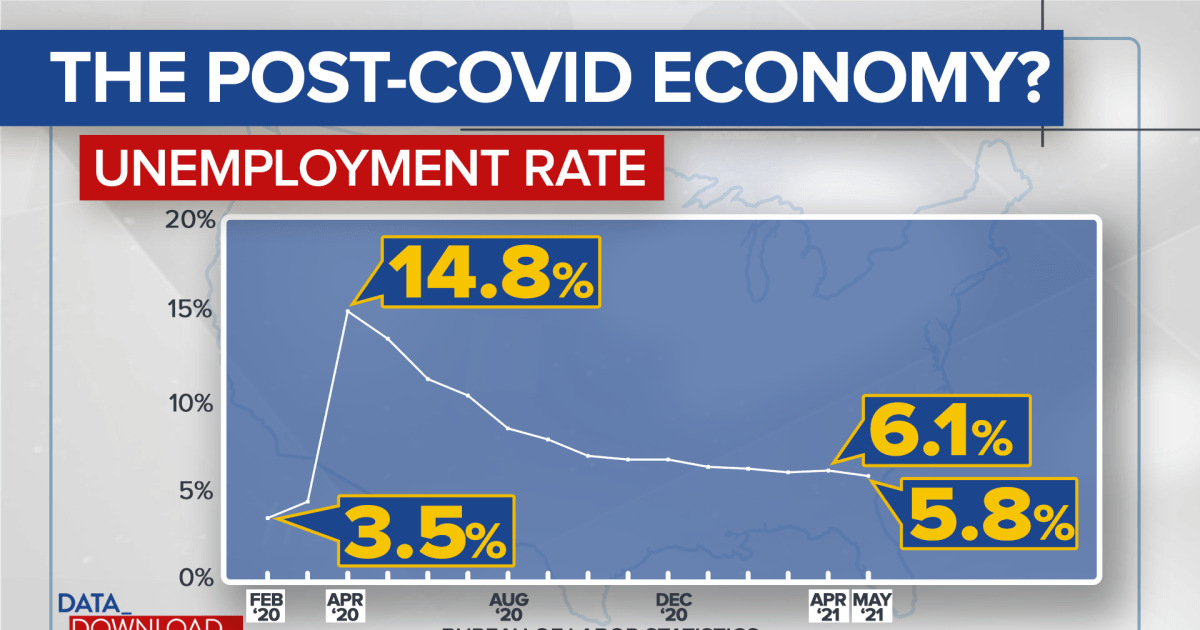
WASHINGTON– Friday brought some welcome work news as the economy included about 560,000 brand-new tasks in Might, knocking the joblessness rate listed below 6 percent. Integrated with the current news about falling Covid-19 case numbers and increasing varieties of Americans’ getting immunized, lots of experts expect a financial boom this summer season as a complete resuming draws nearer.
However it may not be that easy. There are indications that a wider shift may be remaking the economy in manner ins which make it more difficult to see the roadway ahead.
Let’s begin with recently’s task numbers. They were plainly an excellent indication in general.
The joblessness rate was up to 5.8 percent in May, compared to 6.1 percent in April. And compared to May 2020, when the economy was still deep in its Covid-19- caused haze, the rate is down by more than 7 points.
The joblessness number is still not to its incredibly low pre-pandemic variety of 3.5 percent, however the pattern is great, and 5.8 percent isn’t a dreadful number for an economy that invested 2020 being pounded by a pandemic. There is a genuine factor to feel positive about the Might joblessness rate.
However the genuine story of the Covid-19 economy might be seen in a less-discussed number. While individuals tend to concentrate on the joblessness rate, that is based upon the variety of working-age Americans really looking for tasks (the variety of individuals actively “taking part” in the workforce), and it looks a lot various today than it did a year earlier.
In general, manpower involvement is down by more than 1.5 portion points considering that the pandemic started (and the number didn’t actually alter from April to Might). That may not seem like a lot, however bear in mind that we are discussing the overall variety of Americans trying to find tasks. That’s a quite huge swimming pool of individuals, and in genuine terms, the drop shows a decline of about 3.5 million individuals.
The decreasing portion is a little greater amongst females, however both sexes have actually dipped, and the drops amongst both males and females demonstrate how deeply rooted the modification may be.
It’s not weird for workforce involvement to drop throughout an economic downturn. Employees get dissuaded and leave the task swimming pool. And manpower involvement has actually been succumbing to years as the country ages. Individuals ultimately age out of the labor force and retire.
However the size and suddenness of the current drop are exceptional, and the present figures are incredibly low. Simply how low ends up being obvious when you take a look at the historic pattern.
The last time workforce involvement was this low was more than 40 years earlier, in January1977 That indicates present manpower involvement is lower than it was throughout the tech bust or simply after the Sept. 11, 2011, terrorist attacks or throughout the Great Economic downturn.
Think about all the modifications in the economy in the last 40 years. There were no web or mobile phones, and, more crucial, ladies had not yet been completely incorporated into the labor force in the late 1970 s. When females totally went into the manpower, the involvement rate increased greatly, by more than 17 points, from 1960 to 2001.
Simply put, the U.S. labor force is drastically various today than it remained in 1977, and the truth that workforce involvement is as low as it is may suggest a major financial modification is afoot.
Some financial experts argue that Covid-19 relief checks are preventing individuals from work or that range knowing in grades K-12 is keeping some moms and dads in the house to see their kids which those elements might be playing some function.
However the pandemic has actually likewise altered how we do things, from more online shopping and food purchasing to less travelling and less theater gos to. The net outcome of a number of those modifications was more automation and less individual interaction– less counter employees and waitresses, cabdrivers and bartenders. In the Might labor report, leisure and hospitality joblessness was still in double digits.
The concern is whether we are seeing long-lasting behavioral shifts or short-term changes.
The manner in which concern is responded to will have a huge effect not simply on the variety of individuals who are out of work however maybe on the number that is even trying to find tasks to start with.
CORRECTION(June 6, 2021, 9: 25 p.m. ET): A previous variation of this short article misstated when the joblessness rate was last near its pandemic high. It remained in May 2020, not May 2021.
Dante Chinni
Dante Chinni is a factor to NBC News focusing on information analysis around projects, politics and culture.
No comments:
Post a Comment